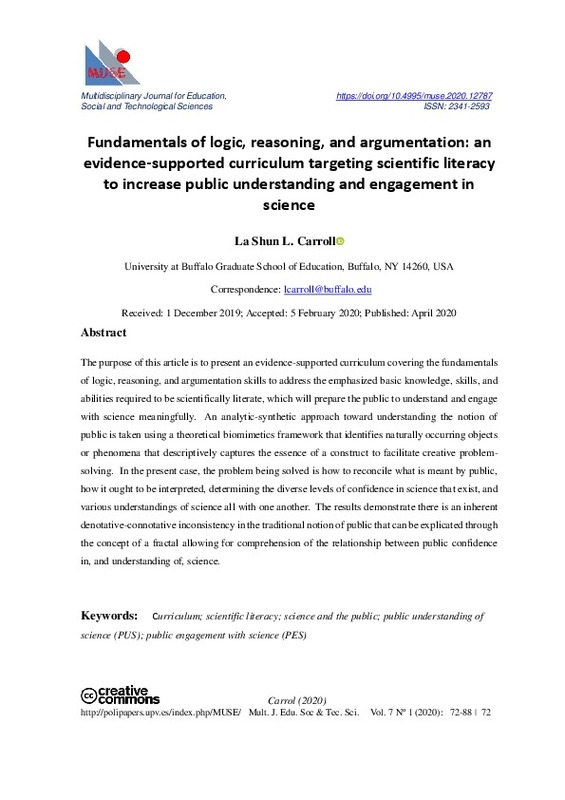JavaScript is disabled for your browser. Some features of this site may not work without it.
Buscar en RiuNet
Listar
Mi cuenta
Estadísticas
Ayuda RiuNet
Admin. UPV
Inquiry learning for gender equity using History of Science in Life and Earth Sciences’ learning environments
Mostrar el registro sencillo del ítem
Ficheros en el ítem
| dc.contributor.author | Sousa, C.
|
es_ES |
| dc.date.accessioned | 2017-01-17T12:33:19Z | |
| dc.date.available | 2017-01-17T12:33:19Z | |
| dc.date.issued | 2016-03-22 | |
| dc.identifier.uri | http://hdl.handle.net/10251/76941 | |
| dc.description.abstract | [EN] The main objective of the present work is the selection and integration of objectives and methods of education for gender equity within the Life and Earth Sciences’ learning environments in the current portuguese frameworks of middle and high school. My proposal combines inquiry learning-teaching methods with the aim of promoting gender equity, mainly focusing in relevant 20th century women-scientists with a huge contribute to the History of Science.The hands-on and minds-on activities proposed for high scholl students of Life and Earth Sciences onstitute a learnig environment enriched in features of science by focusing on the work of two scientists: Lynn Margulis (1938-2011) and her endosymbiosis theory of the origin of life on Earth and Inge Leehman (1888-1993) responsible for a breakthrough regarding the internal structure of Earth, by caracterizing a discontinuity within the nucleus, contributing to the current geophysical model. For middle scholl students the learning environment includes Inge Leehman and Mary Tharp (1920-2006) and her first world map of the ocean floor. My strategy includes features of science, such as: theory-laden nature of scientific knowledge, models, values and socio-scientific issues, technology contributes to science and feminism. In conclusion, I consider that this study may constitute an example to facilitate the implementation, by other teachers, of active inquiry strategies focused on features of science within a framework of social responsibility of science, as well as the basis for future research. | es_ES |
| dc.description.sponsorship | Special thanks to the ones that inspired me. The views expressed in this paper are those of the author. The author would like to thank Universidade do Porto, Portugal, for financial support. | |
| dc.language | Inglés | es_ES |
| dc.publisher | Universitat Politècnica de València | |
| dc.relation.ispartof | Multidisciplinary Journal for Education, Social and Technological Sciences | |
| dc.rights | Reconocimiento - No comercial - Sin obra derivada (by-nc-nd) | es_ES |
| dc.subject | Features of Science | es_ES |
| dc.subject | Gender equity | es_ES |
| dc.subject | Inquiry | es_ES |
| dc.subject | Teaching sciences | es_ES |
| dc.subject | Women in science | es_ES |
| dc.subject | Feminism | es_ES |
| dc.subject | History of science | es_ES |
| dc.title | Inquiry learning for gender equity using History of Science in Life and Earth Sciences’ learning environments | es_ES |
| dc.type | Artículo | es_ES |
| dc.date.updated | 2017-01-16T13:09:52Z | |
| dc.identifier.doi | 10.4995/muse.2016.3762 | |
| dc.rights.accessRights | Abierto | es_ES |
| dc.description.bibliographicCitation | Sousa, C. (2016). Inquiry learning for gender equity using History of Science in Life and Earth Sciences’ learning environments. Multidisciplinary Journal for Education, Social and Technological Sciences. 3(1):84-99. https://doi.org/10.4995/muse.2016.3762 | es_ES |
| dc.description.accrualMethod | SWORD | es_ES |
| dc.relation.publisherversion | https://doi.org/10.4995/muse.2016.3762 | es_ES |
| dc.description.upvformatpinicio | 84 | es_ES |
| dc.description.upvformatpfin | 99 | es_ES |
| dc.type.version | info:eu-repo/semantics/publishedVersion | es_ES |
| dc.description.volume | 3 | |
| dc.description.issue | 1 | |
| dc.identifier.eissn | 2341-2593 | |
| dc.contributor.funder | Universidade do Porto |











